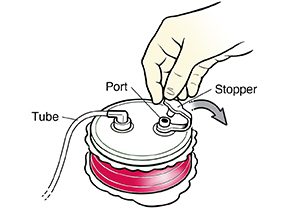The article titled “Understanding the Function of Hemovac Drain” provides readers with an in-depth understanding of the function and significance of the Hemovac drain, a medical device commonly used in surgical procedures. This informative piece aims to equip readers with accurate and factual information about the Hemovac drain, helping them comprehend its vital role in post-operative care and the management of surgical fluid accumulation. By exploring its mechanism, benefits, and proper usage, this article serves as a valuable resource for individuals seeking comprehensive knowledge on this medical tool.
Understanding the Function of Hemovac Drain

Overview of Hemovac Drain
The Hemovac drain is a medical device used to remove fluid or excess blood from a surgical site. It consists of a flexible tube connected to a suction mechanism, allowing for the collection and storage of fluid while maintaining a negative pressure.
Purpose of Hemovac Drain
The primary purpose of a Hemovac drain is to prevent the accumulation of fluid or blood at the surgical site. By creating negative pressure, the drain helps to reduce the risk of hematoma formation, infection, and other complications. Additionally, it provides a means to monitor the amount and appearance of drainage, providing valuable information to the healthcare team.

Components of Hemovac Drain
A typical Hemovac drain consists of several components. These include the drain tube, a collection chamber, a compression device, and a drainage port. The drain tube is a flexible, perforated tube that is inserted into the surgical site to facilitate the drainage process. The collection chamber is a container that holds the fluid or blood collected by the drain. The compression device helps to maintain a negative pressure, while the drainage port allows for the removal and disposal of the collected fluid.
How Hemovac Drain Works
The Hemovac drain operates on the principle of negative pressure. Once the drain tube is inserted into the surgical site, the collection chamber is compressed, creating a vacuum effect. This negative pressure allows fluid or blood to be drawn into the drain tube, where it is collected in the chamber. Regular emptying of the collection chamber is necessary to ensure continuous drainage.

Preparation for Hemovac Drain Placement
Prior to the placement of a Hemovac drain, proper preparation is essential. This includes a thorough assessment of the patient’s condition, ensuring the need for drainage. The site where the drain will be inserted is cleaned and prepped according to sterile protocol. The healthcare provider will also ensure that all necessary equipment and supplies are readily available, including the Hemovac drain kit.
Hemovac Drain Placement Procedure
The procedure for placing a Hemovac drain involves several steps. The healthcare provider will first administer local anesthesia to numb the area where the drain will be inserted. They will then make a small incision, usually near the surgical site, and carefully insert the drain tube. The tube is secured in place using sutures or adhesive dressings. The collection chamber is then connected to the drain tube, and the compression device is activated to create negative pressure.
Management and Care of Hemovac Drain
Proper management and care of the Hemovac drain are crucial to ensure its effectiveness and minimize the risk of complications. Strict aseptic technique should be followed during dressing changes to prevent infection. The collection chamber should be emptied regularly, following the healthcare provider’s instructions. Measurement and documentation of drainage volume, color, and consistency should be done as per protocol. The drain site should be inspected for signs of infection, such as redness, swelling, or discharge. If any complications or concerns arise, immediate medical attention should be sought.
Potential Complications of Hemovac Drain
Although the use of a Hemovac drain is generally safe, there are potential complications that can arise. These include infection at the drain site, blocked or kinked drain tubing, excessive bleeding, damage to surrounding tissues, accidental removal of the drain, and pain or discomfort. It is important for patients and healthcare providers to be vigilant for any signs or symptoms of complications and act accordingly.
Removing Hemovac Drain
The removal of a Hemovac drain is typically determined by the healthcare provider based on various factors, such as the amount and appearance of drainage, the healing progress of the surgical site, and the absence of infection or other complications. The removal procedure is relatively simple and involves gently removing the sutures or dressings securing the drain tube, then carefully withdrawing the tube from the surgical site. Dressings or steri-strips may be applied to the site afterwards, depending on the healthcare provider’s preference.
Conclusion
In conclusion, the Hemovac drain plays a crucial role in surgical wound management by facilitating the removal of fluid or excess blood from the site. Its function, components, and placement procedure are essential knowledge for healthcare professionals involved in surgical care. Proper management, care, and monitoring are necessary to ensure its success and minimize the risk of complications. By understanding the function of the Hemovac drain, healthcare providers can effectively incorporate it into their practice, ultimately contributing to improved patient outcomes.










